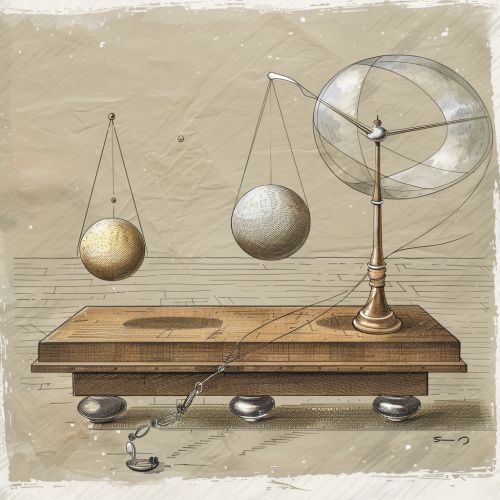Newton's laws of motion
Introduction
Newton's laws of motion are three physical laws that form the foundation for classical mechanics. They describe the relationship between a body and the forces acting upon it, and its motion in response to those forces. These laws have been expressed in several different ways over nearly three centuries, and can be summarized as follows:
1. First law (Law of Inertia): A body at rest tends to stay at rest, and a body in motion tends to stay in motion with the same speed and in the same direction, unless acted upon by a net external force. 2. Second law (Law of Acceleration): The acceleration of a body is directly proportional to, and in the same direction as, the net force acting on the body, and inversely proportional to its mass. 3. Third law (Law of Action and Reaction): For every action, there is an equal and opposite reaction.


Historical Context
The laws of motion were first compiled by Isaac Newton in his work Principia Mathematica, first published in 1687. Newton used these laws to explain and investigate the motion of many physical objects and systems. These laws are important not only in the study of physics, but also in understanding how objects move in everyday life.
Newton's First Law of Motion
The first law, also known as the Law of Inertia, states that an object will remain at rest or in uniform motion in a straight line unless acted upon by an external force. This law is often simplified as "an object in motion stays in motion."
Understanding Inertia
Inertia is the resistance of any physical object to a change in its state of motion. This includes changes to the object's speed, direction, or state of rest. Inertia is a fundamental property of matter and is dependent on an object's mass - the greater the mass of an object, the greater its inertia, and the greater the force required to change its motion.
Newton's Second Law of Motion
The second law, also known as the Law of Acceleration, states that the acceleration of an object is directly proportional to the net force acting upon it and inversely proportional to its mass. This law can be summarized by the equation F = ma, where F is the net force acting on the object, m is the mass of the object, and a is the acceleration.
Understanding Acceleration
Acceleration is a measure of how quickly an object changes its velocity. It is a vector quantity, meaning it has both magnitude (speed) and direction. An object accelerates whenever it changes its speed or direction of motion.
Newton's Third Law of Motion
The third law, also known as the Law of Action and Reaction, states that for every action, there is an equal and opposite reaction. This means that any force exerted on a body will create a force of equal magnitude but in the opposite direction on the object that exerted the first force.
Understanding Action and Reaction
In every interaction, there is a pair of forces acting on the two interacting objects. The size of the forces on the first object equals the size of the force on the second object. The direction of the force on the first object is opposite to the direction of the force on the second object. Forces always come in pairs - equal and opposite action-reaction force pairs.
Applications and Examples of Newton's Laws
Newton's laws of motion are widely used to analyze the motion of many different physical systems. In particular, they can be used to derive the equations of motion for a wide variety of mechanical systems, such as vehicles, construction equipment, and even planets and galaxies.
